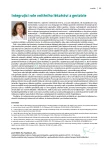Electrolyte and water disorders in old age
Authors:
Zdeněk Zadák 1; Alena Tichá 1,2; Radomír Hyšpler 1,2
Authors‘ workplace:
Centrum pro výzkum a vývoj FN Hradec Králové
1; Ústav klinické biochemie a diagnostiky LF UK a FN Hradec Králové
2
Published in:
Vnitř Lék 2018; 64(11): 1059-1066
Category:
Overview
Changes in the volume and composition of body fluids are among the essential and limiting parameters both in health and illness. These parameters gain in importance with increasing age. Within the concept of a geriatric patient, disturbances in water and mineral metabolism are the cause of circulatory collapse, stroke, and further instability, falls and delirium. The body can, in the broad range of balance within internal environment, compensate for variations, however always for a limited length of time only, and this compensation ability decreases in particular in older age. Maintaining of water and mineral balance in the elderly is also complicated by polymorbidity. Frequent occurrence of cardiovascular diseases and decline in renal functions later in life results in reduced compensation abilities, which status must be rigorously considered. Besides polymorbidity, also polypragmasia in pharmacotherapy is very frequently encountered in relation to age-related disorders of water and electrolyte handling. Treatment with sedatives also suppresses the feeling of thirst, which results in rapid development of disturbances in water and mineral balance even after small insults, such as feverish illnesses and minor injuries. The knowledge of differences in diagnosing and treatment of water and ion imbalances in later life is becoming increasingly important, especially with regard to the increasing share of older people in society.
Key words:
ageing – dehydration – electrolyte metabolism – mineral disorders
Sources
- Kaška M, Zadák Z, Živný P et al. Vliv vysokého věku na vnitřní prostředí operovaných. In: Stárnutí populace – důsledky pro současnou medicínu. Česká gerontologická a geriatrická společnost ČLS JEP: Praha 2003. ISBN: 80–239–1484–7.
- Rowe JW, Andres R, Tobin JD et al. The effect of age on creatinine clearance in men: A cross-sectional and longitudinal study. J Gerontol 1976; 31(2): 155–163.
- Davies D, Shock N. Age changes in glomerular filtration rate, effective renal plasma flow, and tubular excretory capacity in adult males. J Clin Invest 1950; 29(5): 496–507. Dostupné z DOI: <http://dx.doi.org/10.1172/JCI102286>.
- Zadák Z. Výživa v intenzivní péči. 2. ed. Grada Publishing: Praha 2008.
- Kaška M, Motyčka P, Hyšpler R et al. The laboratory characteristics of perioperative nutrition. Acta Medica (Hradec Králové) 2006; 49(2): 139.
- Asadollahi K, Beeching N, Gill G. Hyponatraemia as a risk factor for hospital mortality. QJM 2006; 99(12): 877–880. Dostupné z DOI: <http://dx.doi.org/10.1093/qjmed/hcl120>.
- Corona G, Giuliani C, Parenti G et al. Moderate hyponatremia is associated with increased risk of mortality: evidence from a meta-analysis. PLOS One 2013; 8(12): e80451. Dostupné z DOI: <http://dx.doi.org/10.1371/journal.pone.0080451>.
- Borra SI, Kleinfeld M, Beredo R. Hypernatremia in the aging: causes, manifestations, and outcome. J Natl Med Assoc 1995; 87(3): 220–224.
- Palevsky PM. Hypernatremia. Semin Nephrol 1998; 18(1): 20–30.
- Lang R. Edema. In: Gennari FJ (ed) Medical management of kidney and electrolyte disorders. Marcel Dekker: New York 2001. ISBN 978–0824788698.
- Kazda A. Vnitřní prostředí I – voda, ionty, osmolalita. In: Kazda A. Kritické stavy. Metabolická a laboratorní problematika. Galén: Praha 2012: 1–30. ISBN 978–80–7262–763–9.
- Zadák Z. Léčba hyperkalcemie. Medicína po promoci 2005; 6(1): 42–44.
- Zadák Z, Tichá A, Hyšpler R. Suplementace hořčíku – farmakologické mechanismy, metody podání a pasti. Klin Farmakol Farm 2017; 31(3): 16–18.
- Hyspler R, Ticha A, Svobodová I et al. Evaluation of magnesium deficiency in the Czech population and the influence of supplementation by magnesium-rich mineral water. Clin Nutr Suppl 2012; 7(Supl 1): 255–256.
Labels
Diabetology Endocrinology Internal medicineArticle was published in
Internal Medicine

2018 Issue 11
Most read in this issue
- Thermoregulatory disorders and their significance in the elderly
- Sarcopenia as a severe organ failure, its diagnosing and present therapeutic possibilities
- Electrolyte and water disorders in old age
- Falls: a significant cause of morbidity and mortality in elderly people
